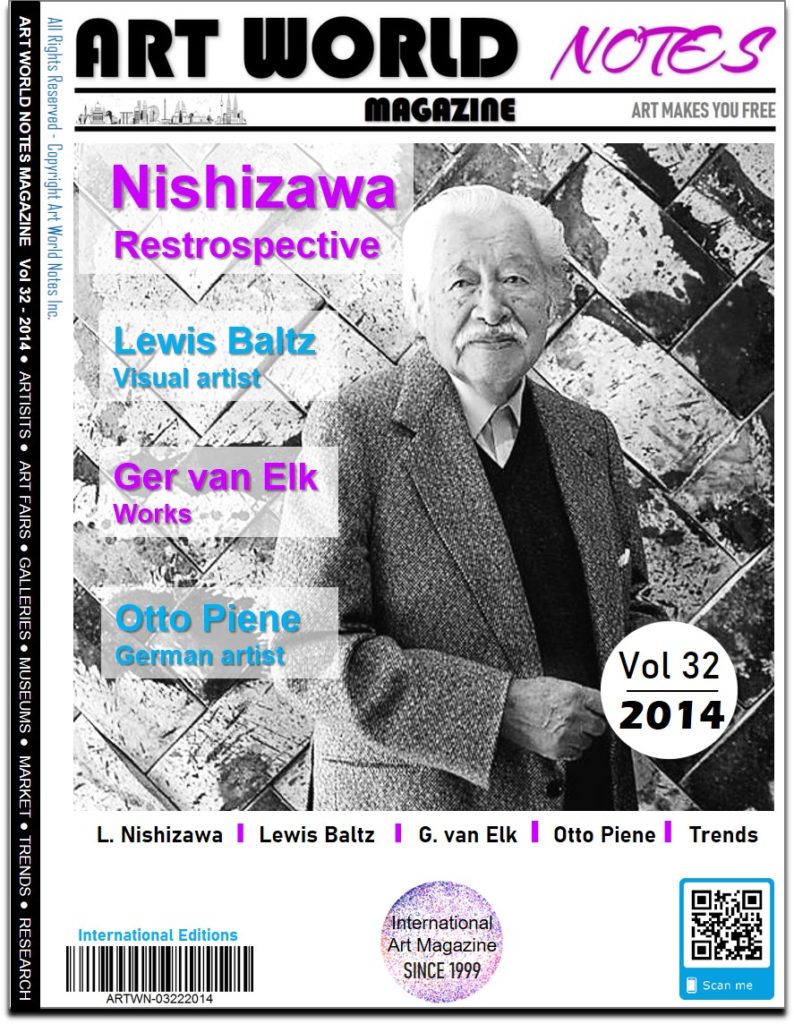
ART WORLD NOTES
MAGAZINE Vol 32
2014 – Semester 02
Nishizawa
Retrospective
Cover: Luis Nishizawa (1918-2014) Painter, Sculptor. Over his career Nishizawa employed various techniques and styles in his work, with some of his best known work being in ink. He is one of few painters who also draws as an end rather than just a means. Most of his work is dedicated to nature, the universe and the human figure, with much of the imagery influenced by his childhood contact with the landscape of Mexico.
His Japanese and Mexican ethnic heritage is evident in his work, with themes mostly related to Mexico but Japanese style and technique evident, especially with the use of color. Nishizawa was a painter, engraver, graphic artist, sketch artist and ceramicist. His techniques include drawing, watercolor and ink. Most of his works depict landscapes of the central highlands of Mexico such as the Valley of Mexico, areas in Morelos, Guanajuato, Puebla and the State of Mexico.
He is considered to have been one of Mexico’s best landscape artists, known for his paintings of volcanoes.Some of his more important canvases include Paisaje: Valle de México (1947), Paisaje de Yagul (1976) and Pátzcuaro (1960) where the blending of this Mexican and Japanese heritage and training are evident. His works have been exhibited in the Museo de Arte Moderno for over forty years, but most of his works can be found in the permanent collection of the Museo Taller Nishizawa. He created murals, paintings, drawings, ceramic and glass pieces and sculpture.
His works can be found in the permanent collections of the Centro Cultural Mexiquense in Toluca, the Museo de Bellas Artes in Toluca, the Instituto Nacional de Bellas Artes y Literatura, the Museo de la Estampa and the Museo Carrillo Gil, the Engraving Museum in Bulgaria, the Culture Museum in Yokohama, the Museum of Modern Art in Kyoto and the Shinanu Museum in Nagano. His works are also held in private collections in Mexico, Japan and the United States.
He participated in numerous individual and collective exhibition in Mexico and abroad, with his first individual exhibition in 1951. Individual exhibitions include Pago en especie in Cancún (a collection of paintings donated to the Secretaría de Hacienda y Crédito Público), Retrospective in the Gallery of the University of Colima,
De Ayer y Hoy at the Teléfonos de México, The work of Nishizawa at the Ruth Hermose Galleries in San Francisco as well as various exhibitions at the Salón de las Plástica Mexicana and the Instituto Nacional de Bellas Artes, and “Las vacas flacas y los sueños rotos” in various locations and times. In 1995, the Casa de Cultura in Cancún held an exhibition to honor his life’s work. The Institutto Nacional de Bellas Artes y Literature sponsored an exhibition of his life’s work at the Museo Nacional de San Carlos in 2008.
Nishizawa painted his first major mural “El aire es vida y la salud es la mayor riqueza” at the Centro Médico Siglo XXI, with another shortly after in 1969 at the Hospital General de Zona No. 4 in Celaya, Guanajuato with the name of “El Nacimiento de la Vida” done with high fire ceramics. One of his important works is a ceramic mural done in a Keisei metro station in Japan in 1981. Other murals are found at the Centro Cultural Martí, the Centro Cultural Universitario, the General Archives of the State of Mexico in Toluca, the Procuraduría General de la República and the Secretaría de Educación Pública.One of his most recent murals is “La Justicia,” which was created in the main stairwell of the Mexican Supreme Court for the Bicentennial of Mexico´s Independence in 2010.

